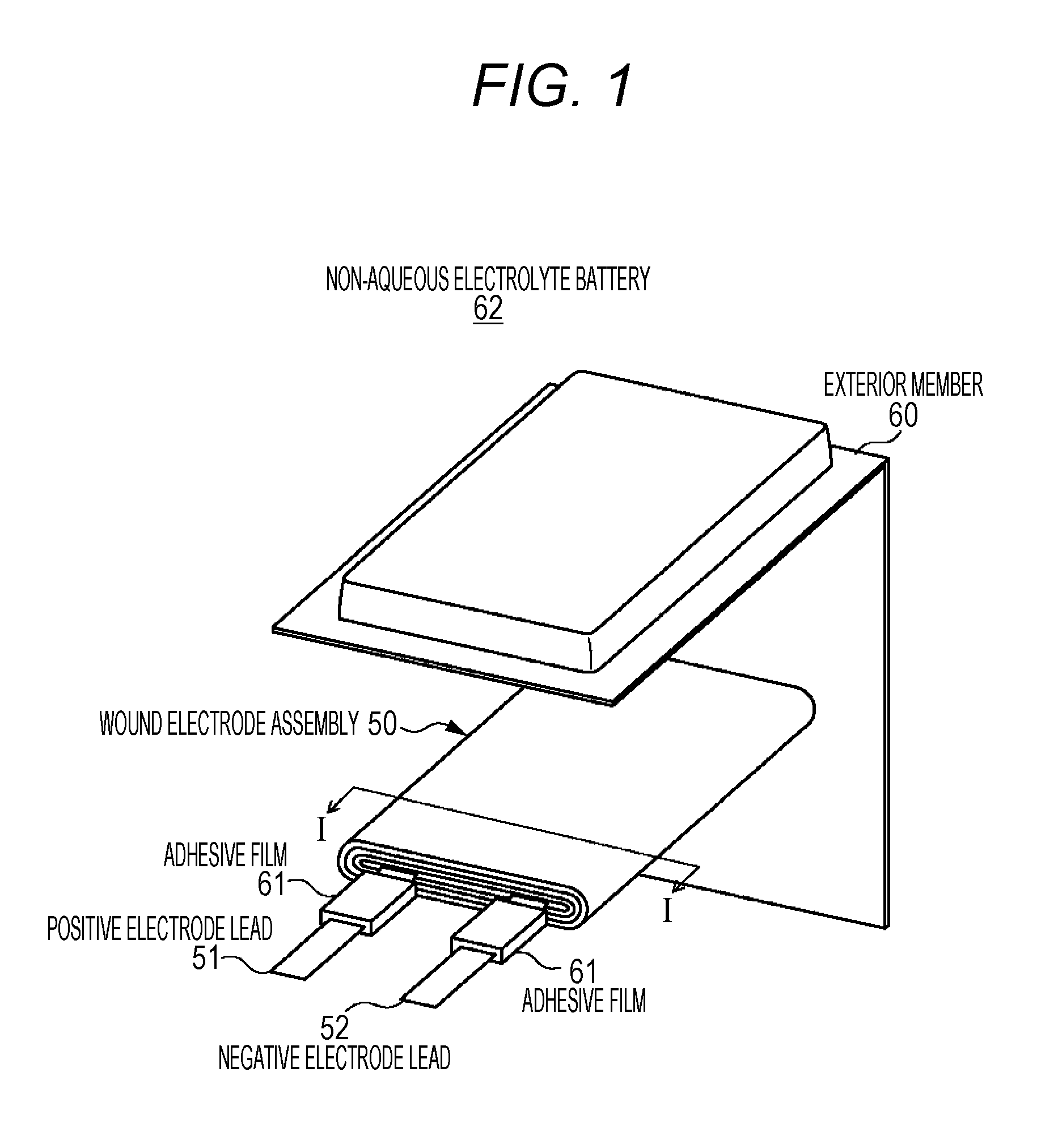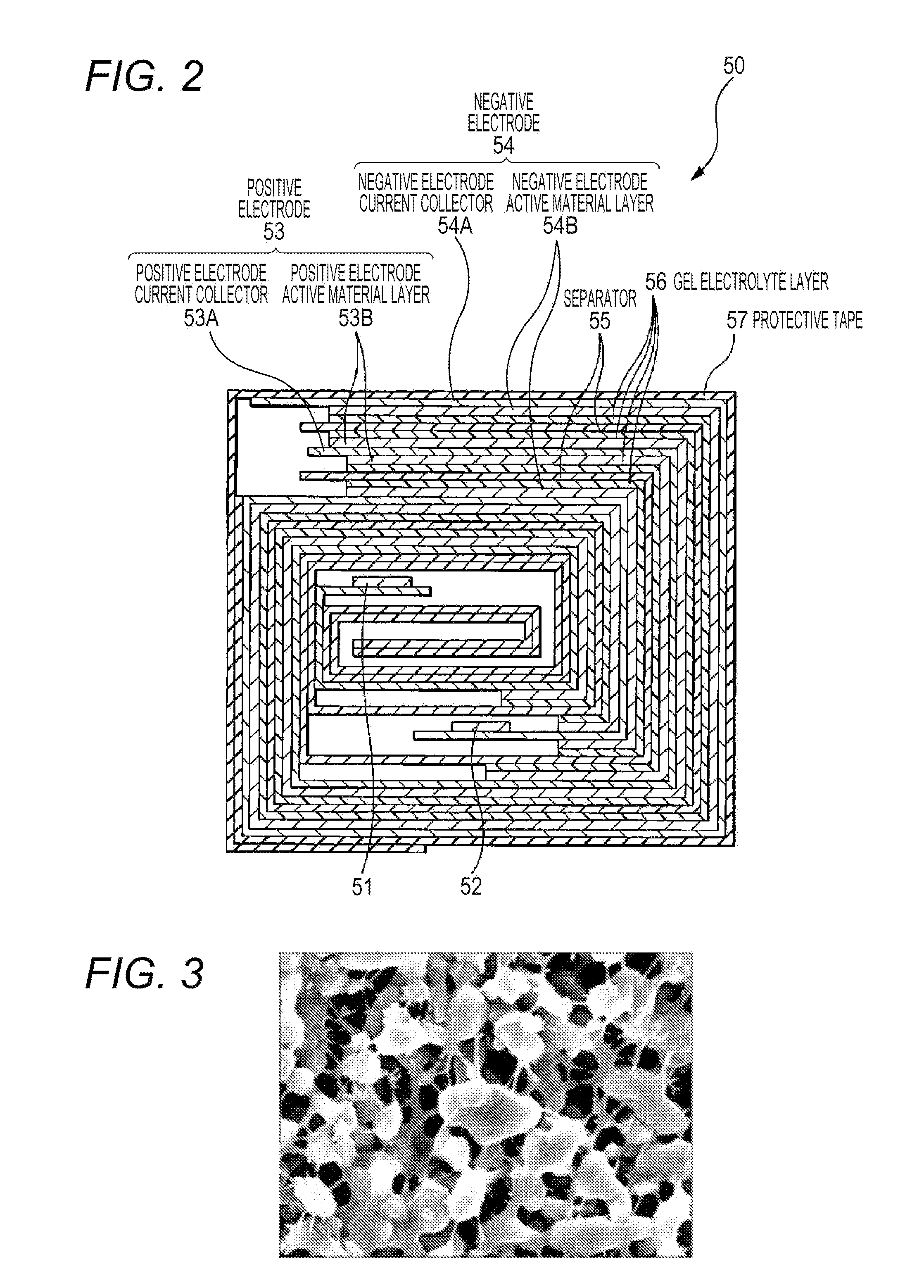Battery, electrolyte layer, battery pack, electronic apparatus, electric vehicle, power storage device, and electric power system
a battery and electrolyte technology, applied in the field of batteries, can solve the problems of large amount of heat emitted from the negative electrode side, inability to keep heat dissipation, and inability to avoid temperature increase in the battery,
- Summary
- Abstract
- Description
- Claims
- Application Information
AI Technical Summary
Benefits of technology
Problems solved by technology
Method used
Image
Examples
first embodiment
1. First Embodiment
[0034](1-1) Configuration of Non-Aqueous Electrolyte Battery
[0035]In the first embodiment, a laminate film type battery will be explained.
[0036]FIG. 1 illustrates the configuration of a non-aqueous electrolyte battery 62 according to the first embodiment. This non-aqueous electrolyte battery 62 is a so-called laminate film type, in which a wound electrode assembly 50 equipped with a positive electrode lead 51 and a negative electrode lead 52 is accommodated inside a film-like exterior member 60.
[0037]The positive electrode lead 51 and the negative electrode lead 52 are respectively led out from the interior of the exterior member 60 toward the outside, for example, in the same direction. The positive electrode lead 51 and the negative electrode lead 52 are respectively constructed from, for example, a metal material such as aluminum, copper, nickel or stainless steel, and are respectively formed in a thin plate form or a mesh form.
[0038]The exterior member 60 is f...
first example
Production Method Based on Phase Separation
[0142]A resin material and particles that constitute a resin layer are mixed at a predetermined ratio, the mixture is added to a dispersing solvent such as N-methyl-2-pyrrolidone, and a resin solution is obtained by dissolving the resin material. Subsequently, this resin solution is applied or transferred on at least one surface of the separator 55. Meanwhile, the resin solution is applied or transferred by adjusting the amount of particles per unit area so as to satisfy the condition of the present technology that the total heat capacity per unit area should be 0.0001 J / Kcm2 or more. An example of the method for applying the resin solution is a method of coating by means of a bar coater or the like.
[0143]Subsequently, the separator 55 having the resin solution coated thereon is immersed in a water bath, thereby the resin solution is subjected to phase separation, and thus a resin layer is formed. The resin solution applied on the separator...
second example
Production Method Based on Drying at High Temperature
[0155]A resin solution is obtained by mixing a resin material and particles that constitute the resin layer at a predetermined mass ratio, adding the mixture to a dispersing solvent such as 2-butanone (methyl ethyl ketone; MEK) or N-methyl-2-pyrrolidone (NMP), and dissolving the mixture. Subsequently, this resin solution is applied on at least one surface of a separator. Meanwhile, the resin solution is applied while the amount of particles per unit area is adjusted so as to satisfy the condition of the present technology that the total heat capacity per unit area should be 0.0001 J / Kcm2 or more.
[0156]Subsequently, the separator 55 coated with the resin solution is dried by, for example, a method such as passing the separator through a drying furnace so as to volatilize the dispersing solvent, and thus a resin layer is formed. At this time, it is preferable to set the temperature at the time of drying to be sufficiently high for t...
PUM
| Property | Measurement | Unit |
|---|---|---|
| glass transition temperature | aaaaa | aaaaa |
| open circuit voltage | aaaaa | aaaaa |
| open circuit voltage | aaaaa | aaaaa |
Abstract
Description
Claims
Application Information
 Login to View More
Login to View More - R&D
- Intellectual Property
- Life Sciences
- Materials
- Tech Scout
- Unparalleled Data Quality
- Higher Quality Content
- 60% Fewer Hallucinations
Browse by: Latest US Patents, China's latest patents, Technical Efficacy Thesaurus, Application Domain, Technology Topic, Popular Technical Reports.
© 2025 PatSnap. All rights reserved.Legal|Privacy policy|Modern Slavery Act Transparency Statement|Sitemap|About US| Contact US: help@patsnap.com



